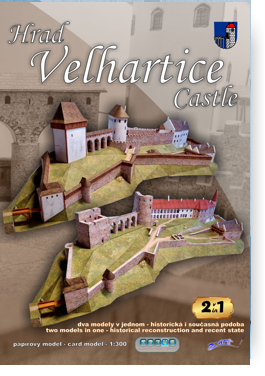

VELHARTICE CASTLE
How time went with the castle owners
1318 - 1390: the Lords of Velhartice
The castle and its first known owner, Bušek of Velhartice, are first mentioned in 1318. When Bušek, a loyal valet of the then Margrave Charles (the future Emperor Charles IV), died in Merano during Charles's Italian expedition in 1337, his eponymous son Bušek Jr. As master of the chamber, he also worked very often in the company of the king, a fact made very popular by Jan Neruda in his ballad Romance of Charles IV, which begins with that famous verse:
King Charles with Bušek of Vilhartice
Now they sat down at the oak table -
the two have drunk many a cup together
and sang at the top of their lungs.
After the death of Bušek Jr., which probably took place in 1371, his son Jan took over the family seat, and with his death in 1390, the main branch of the Velhartice family died out by the sword.
1395-1453: Lords of Hradec
In 1395, Jan the Elder of Hradec became the sole owner of Velhartice, who first acquired half of the Velhartice estate through his marriage to Katherine of Velhartice and bought the other half from Henry III of Rožmberk. His son Menhart and after him John's grandson Oldřich were the last owners of Velhartice from this family. Oldřich of Hradec died in 1453.
1454-1540
After the Lords of Rýzmberk, Zdeněk Lev of Rožmital bought Velhartice in 1506. After his death in 1535, his son Adam Lev of Rožmital undertook to repay his father's debts, which eventually led to the sale of Velhartice to Adam of Šternberk.
1540-1620
In 1589, the Šternberks' management led to the division of the estate and the castle was acquired by Jindřich Plánský of Žeberk. Volf Perglar of Perglas bought Velhartice in 1597 from his grandson. His son Václav Otakar joined the side of the Protestants during the Estates Uprising,and therefore his property was confiscated after the Battle of White Mountain.
1628-1653
In 1628, the castle was bought from General Balthasar Marradas for 55,000 rhinestones by the imperial general Martin de Hoeff-Huerta. In order to allow this Dutch-Spanish nobleman to acquire property in the Czech lands, the Emperor granted him an incollative on 20 November 1628, which was the only way for foreign nobility to acquire confiscated property in our territory cheaply at that time. Hoeff-Huerta was promoted to the nobility with the surname of Velhartice. On all his estates, including Velhartice, he was famous for his violent promotion of recatholization. It was not until ten years later that Hoeff-Huert's adopted daughter Anna Maria received Velhartice as an inheritance. In 1653, the indebted estate was sold to the Carmelites from Prague's Lesser Town.
1653 - until now
The year 1653 marks the beginning of a long period of frequent changes of owners of the castle, which almost always led to one thing in all aristocratic estates - the decline and gradual transformation of the estate into a ruin. It was not until the mid-19th century, in the spirit of the emerging Romantism and historism, that the then owner Karel Sturmfelder of Oppenweiler set about saving the building and repairing it. The castle underwent another significant architectural alteration after 1930, when the Huertas Palace was rebuilt according to the design of the architect K. Pecánek.
After World War II, the castle was nationalised and its owner became the Pilsen Regional National Committee, which had the building declared a cultural monument in 1964. At that time the castle served as a recreation centre. It was declared a national cultural monument in 2001 and is currently looked after by the National Heritage Institute in Prague. In 1983-2019 Petr Mejstřík was the castellan of the castle, after whom his son Matěj, who has been the castellan until the present day, took over the position.
TOUR AND CONSTRUCTION DEVELOPMENT OF THE CASTLE
Before you start building the models themselves, get to know the individual parts of the castle.
The extensive castle grounds are entered through a gothic gate in the accompanying square tower, in front of which there used to be a moat. In front of the lower part of the castle there is a narrow parkland and behind it a wall fortified with a round bastion and a high tower on the left. From the Gothic part of the castle, the ruins of a residential palace called the Paradise House have been preserved, connected by a massive stone bridge to the opposite tower called Putna, which was once accessed from the bridge by a drawbridge to a preserved Gothic portal on the first floor. The tower was three storeys high, with a staircase leading to the upper floors in its south-west wall. The adjacent Renaissance palace was added to the old castle wall, in which the Gothic portal and loopholes remain. This Renaissance wing, rebuilt in the 19th century, is connected to the oldest part of the castle with a Gothic chapel and a cylindrical tower.
Velhartice Castle is a typical example of the masterful use of terrain for the construction of a well-protected noble residence. The castle was founded on a narrow promontory that drops steeply through rocky cliffs into a deep ravine formed by the Pstružná River. The oldest core of the castle exactly followed the shape of the rock spur. It was a steep triangle, facing east at the top and west at the base, surrounded by a wall about 10 m high and over 2 m thick. The courtyard was built up on three sides from the beginning. On the west side there was a palace about 7 m wide, founded on a rock that reached up to the first floor level and formed a gallery about 2,5 m wide, originally covered, in front of its front. The Gothic origins of the north wing are now evidenced only by a series of narrow pointed windows on the 1st floor and slitted doorways on the 2nd floor of the north front. The short wing, which together with the turret closed the courtyard on the eastern side, preserves a Gothic portal on the ground floor.
One of the absolutely unnoticeable structural elements that will dominate your paper model is undoubtedly the massive stone bridge, which was forced to be built by the construction of the new southwestern forecourt, which is otherwise dominated by a large rectangular tower measuring 9.25x18 m called Putna. The stone bridge connecting Putna with the Paradise House is a unique phenomenon in castle architecture, comparable perhaps only to the famous Cloak Bridge in Český Krumlov, which is more than three centuries younger! The original moat that crossed the ridge was filled in and the first square pillar of the stone bridge was founded on the older ward wall. The second pillar is already circular and was built on the outside of the abolished moat, and the other three followed at equal intervals up to the new large tower. Another interesting feature of the bridge is undoubtedly the fact that it actually stands as a separate structure, as there are gaps of about 1.6 m wide on both sides, which were bridged by drawbridges.
We believe that this exceptional architectural object will be as unmissable on your model as it is on Velhartice Castle itself. The author of this introductory text wishes you the best of luck
Miroslav Konopka
You can order in our e-shop.
Back















